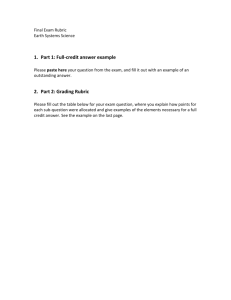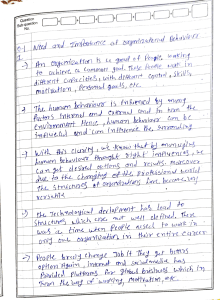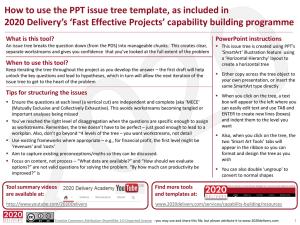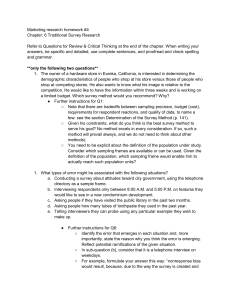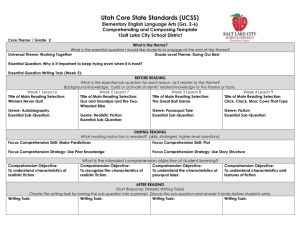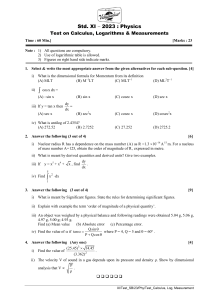RFP Q&A: Childhood Immunization Research in the Philippines
advertisement
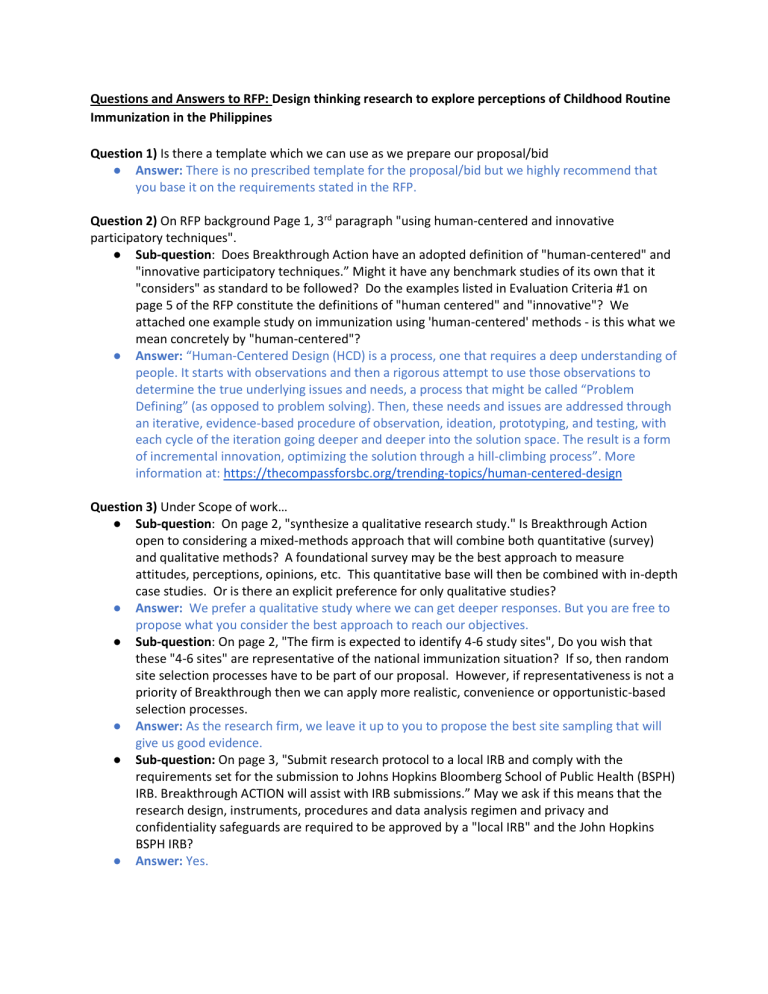
Questions and Answers to RFP: Design thinking research to explore perceptions of Childhood Routine Immunization in the Philippines Question 1) Is there a template which we can use as we prepare our proposal/bid ● Answer: There is no prescribed template for the proposal/bid but we highly recommend that you base it on the requirements stated in the RFP. Question 2) On RFP background Page 1, 3rd paragraph "using human-centered and innovative participatory techniques". ● Sub-question: Does Breakthrough Action have an adopted definition of "human-centered" and "innovative participatory techniques.” Might it have any benchmark studies of its own that it "considers" as standard to be followed? Do the examples listed in Evaluation Criteria #1 on page 5 of the RFP constitute the definitions of "human centered" and "innovative"? We attached one example study on immunization using 'human-centered' methods - is this what we mean concretely by "human-centered"? ● Answer: “Human-Centered Design (HCD) is a process, one that requires a deep understanding of people. It starts with observations and then a rigorous attempt to use those observations to determine the true underlying issues and needs, a process that might be called “Problem Defining” (as opposed to problem solving). Then, these needs and issues are addressed through an iterative, evidence-based procedure of observation, ideation, prototyping, and testing, with each cycle of the iteration going deeper and deeper into the solution space. The result is a form of incremental innovation, optimizing the solution through a hill-climbing process”. More information at: https://thecompassforsbc.org/trending-topics/human-centered-design Question 3) Under Scope of work… ● Sub-question: On page 2, "synthesize a qualitative research study." Is Breakthrough Action open to considering a mixed-methods approach that will combine both quantitative (survey) and qualitative methods? A foundational survey may be the best approach to measure attitudes, perceptions, opinions, etc. This quantitative base will then be combined with in-depth case studies. Or is there an explicit preference for only qualitative studies? ● Answer: We prefer a qualitative study where we can get deeper responses. But you are free to propose what you consider the best approach to reach our objectives. ● Sub-question: On page 2, "The firm is expected to identify 4-6 study sites", Do you wish that these "4-6 sites" are representative of the national immunization situation? If so, then random site selection processes have to be part of our proposal. However, if representativeness is not a priority of Breakthrough then we can apply more realistic, convenience or opportunistic-based selection processes. ● Answer: As the research firm, we leave it up to you to propose the best site sampling that will give us good evidence. ● Sub-question: On page 3, "Submit research protocol to a local IRB and comply with the requirements set for the submission to Johns Hopkins Bloomberg School of Public Health (BSPH) IRB. Breakthrough ACTION will assist with IRB submissions.” May we ask if this means that the research design, instruments, procedures and data analysis regimen and privacy and confidentiality safeguards are required to be approved by a "local IRB" and the John Hopkins BSPH IRB? ● Answer: Yes. Question 4) On study objectives… ● Sub-question: On Page 2, letter D "Priority Audiences", May we respectfully ask for a definition of "priority audiences" - in order to identify groups, gov't agencies, etc. that the study should target? ● Answer: Priority audience include but not limited to mothers/caregivers of children below 5 years old, husbands/ partners, healthcare providers, and community leaders. ● Sub-question: On Page 2, letter F "a change in attitudes and behavior", From the use of the phrase "a change in attitudes and behavior" we understand that the design may need, at the minimum, two reference time points. May we ask if any prior study was conducted by Breakthrough Action that may serve as reference point 1? Or is the study to be proposed by the bidders expected to create a design that operationalizes some form of reference time points? ● Answer: We know that attitudes and behaviors have negatively changed because immunization rates have changed dramatically.. We don’t know why–if there was a specific incident or if there are new structural barriers or if the COVID-19 pandemic caused a change in attitude towards vaccination, or something else. We are not looking for numbers, we are looking for causes. We expect a qualitative inquiry on what was happening before and whether/how it has shifted in the past couple of years with changes in the routine immunization rates. Question 5) On Proposal Application… ● Sub-question: Three client references are requested. Do we mean clients of the Proponent or clients of the research team members, or both? ● Answer: Both. ● Sub-question: To whom should we address the cover letter? ● Answer: Please address it to Cathy Church-Balin, Country Representative for Breakthrough ACTION Philippines. Question 6) On study sites… ● Sub-question: On page 2, it says "4-6 study sites, focusing on comparing areas with low and high routine immunization rates, both urban and rural”. Does Breakthrough ACTION wish that these 4-6 sites be from separate regions or separate provinces or separate municipalities or separate barangays? ● Answer: As the research firm, we leave it up to you to propose the best site sampling that will give us good evidence. Diversity (regions, provinces, etc) in the sample would provide a broader view of the research questions at hand and would be considered a stronger approach. ● Sub-question: For areas with extremely low rates of childhood routine immunization rates, is it required to cover areas such as SOCCSKSARGEN (25-50% rate of receiving all vaccinations) and BARMM (0-25% rate of receiving all vaccinations)? Or can low rates be limited to the level of 5075%, which comprises the majority of the country's regions? ● Answer: As the research firm, we leave it up to you to propose the best site sampling that will give us good evidence. While easier to access areas might provide some insights on low rates, extreme cases such as with low rates in BARMM could provide unique insights that may be important in ensuring equity in reach and effects of the program that is developed based on the results of this study. ● Sub-question: Does Breakthrough Action have any document from the Philippine Statistics Authority or from DOH that identifies the childhood routine immunization rates across cities? ● Answer: If the selected firm cannot obtain this information we will assist. Question 7) On the budget and logistics ● Sub-question: Is there a budget cap for the proposal, and how much? ● Answer: We can’t reveal the budget. Kindly plan your budget according to the activities in the scope of work. Kindly note that Breakthrough Action will award the contract based on best value, cost, and all other factors taken into consideration. ● Sub-question: Will you require full transcription (verbatim) of all interviews conducted (FGDs, KIIs)? ● Answer: We will require the research firm selected to transcribe and translate the data collected to English. ● Sub-question: When interviews are conducted, will you require them to be done at the home site of the target respondents? Or can the respondents be asked to come down to a more accessible interview venue? We ask this as this will impact costs significantly. ● Answer: The sampling and methodology to be employed in the study are to be proposed by the research firm. Selection of interview venues should ensure ease of access and low burden on the respondents. ● Sub-question: When conducting interviews in a remote location/home site, the security and safety of the interviewer is a major concern. Will you be OK to have a 1:1 ratio of supervisor to interviewer so that there will always be at least 2 members of the project team conducting the interviews? ● Answer: The makeup of the study team is up to the research firm. We do advise that study teams do not take unnecessary risks in the implementation of the study when known risks exist in certain areas. Such areas should be substituted by others similar in composition and scale. ● Sub-question: Attendance and transportation tokens. Will you require the research team to provide attendance tokens (to defray lost income of respondents during interview) and transportation tokens (to defray costs of respondents, FGD members, KIIs) of going to the interview venue? ● Answer: Research firms should consider how much time they are anticipating to take from study participants and if significant travel on part of the respondents is part of the study plan. Based on the burden of time and/or cost to the respondents, research firms may consider budgeting in their proposed budget in the bid for any tokens of participation. Question 8) Are there any additional materials on the proposed research topic, including BA's publications on Human-Centered Design/innovative participatory approach. ● Answer: You may check this website for any additional materials and information regarding human-centered design. https://breakthroughactionandresearch.org/our-approaches/humancentered-design/
